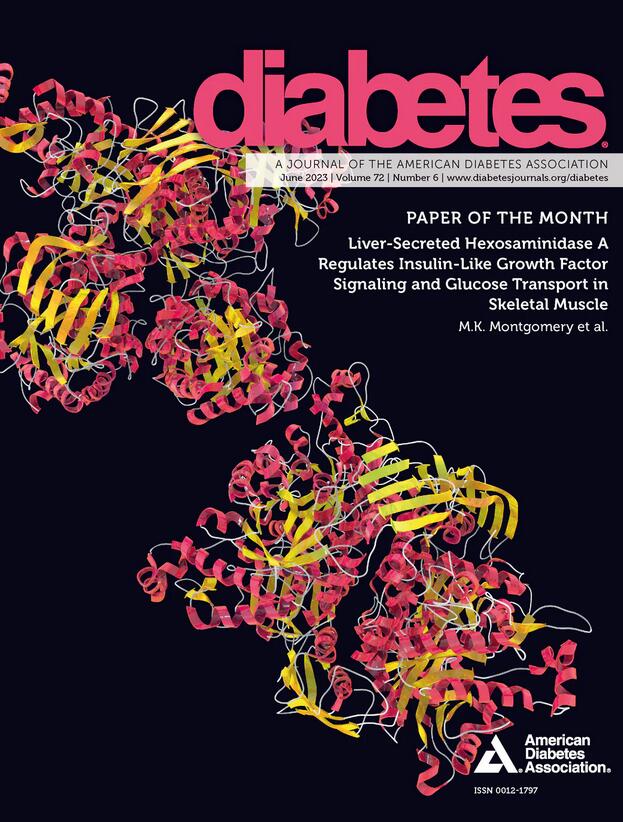对 MIN6 细胞胰岛素颗粒的优化蛋白质组分析发现了胰岛素分泌和含量的新型调节因子 Scamp3。
IF 6.2
1区 医学
Q1 ENDOCRINOLOGY & METABOLISM
引用次数: 0
摘要
朗格汉斯胰岛中的胰岛β细胞通过分泌肽类激素胰岛素来维持葡萄糖稳态。胰岛素被包装在名为胰岛素分泌颗粒(ISGs)的囊泡中,最近人们认为这些囊泡具有内在结构和蛋白质,可调节胰岛素颗粒的成熟、贩运和分泌。以前的研究利用不同的分离技术发现了一些新型的 ISG 相关蛋白。在这里,这项研究将优化的 ISG 分离技术和基于质谱的蛋白质组学技术相结合,并采用无偏见的蛋白质相关性分析和有针对性的机器学习方法,从而有把握地发现了 211 个 ISG 相关蛋白质。其中四个蛋白:Syntaxin-7、Synaptophysin、Synaptotagmin-13 和 Scamp3 以前从未与 ISG 相关。通过共聚焦成像的共聚焦分析,我们验证了这些蛋白在 MIN6 和人类 β 细胞中与 ISG 的关联。我们首次进一步验证了其中一个蛋白(Scamp3)在调节β细胞胰岛素含量和分泌中的作用。敲除 Scamp3 的 INS-1 细胞显示出胰岛素含量减少和胰岛素分泌失调。这些数据为今后研究 Scamp3 在 β 细胞生物学和胰岛素分泌调控中的作用奠定了基础。本文章由计算机程序翻译,如有差异,请以英文原文为准。
Optimised proteomic analysis of insulin granules from MIN6 cells identifies Scamp3, a novel regulator of insulin secretion and content.
Pancreatic β-cells in the Islets of Langerhans are key to maintaining glucose homeostasis, by secreting the peptide hormone insulin. Insulin is packaged within vesicles named insulin secretory granules (ISGs), that have recently been considered to have intrinsic structures and proteins that regulate insulin granule maturation, trafficking, and secretion. Previously, studies have identified a handful of novel ISG-associated proteins using different separation techniques. Here, this study combines an optimized ISG isolation technique and mass spectrometry-based proteomics, with an unbiased protein correlation profiling and targeted machine learning approach to uncover 211 ISG-associated proteins with confidence. Four of these proteins: Syntaxin-7, Synaptophysin, Synaptotagmin-13 and Scamp3 have not been previously ISG-associated. Through colocalization analysis of confocal imaging we validate the association of these proteins to the ISG in MIN6 and human β-cells. We further validate the role for one (Scamp3) in regulating insulin content and secretion from β-cells for the first time. Scamp3 knock-down INS-1 cells show a reduction in insulin content and dysfunctional insulin secretion. These data provide the basis for future investigation of Scamp3 in β-cell biology and the regulation of insulin secretion.
求助全文
通过发布文献求助,成功后即可免费获取论文全文。
去求助
来源期刊

Diabetes
医学-内分泌学与代谢
CiteScore
12.50
自引率
2.60%
发文量
1968
审稿时长
1 months
期刊介绍:
Diabetes is a scientific journal that publishes original research exploring the physiological and pathophysiological aspects of diabetes mellitus. We encourage submissions of manuscripts pertaining to laboratory, animal, or human research, covering a wide range of topics. Our primary focus is on investigative reports investigating various aspects such as the development and progression of diabetes, along with its associated complications. We also welcome studies delving into normal and pathological pancreatic islet function and intermediary metabolism, as well as exploring the mechanisms of drug and hormone action from a pharmacological perspective. Additionally, we encourage submissions that delve into the biochemical and molecular aspects of both normal and abnormal biological processes.
However, it is important to note that we do not publish studies relating to diabetes education or the application of accepted therapeutic and diagnostic approaches to patients with diabetes mellitus. Our aim is to provide a platform for research that contributes to advancing our understanding of the underlying mechanisms and processes of diabetes.
 求助内容:
求助内容: 应助结果提醒方式:
应助结果提醒方式:


